Advanced Principles in Programming - PowerPoint PPT Presentation
Title:
Advanced Principles in Programming
Description:
Advanced Principles in Programming Cal Dietz University of Minnesota * * Athletes adapt quickly, and we must continue to keep the body guessing and adapting in order ... – PowerPoint PPT presentation
Number of Views:221
Avg rating:3.0/5.0
Title: Advanced Principles in Programming
1
Advanced Principles in Programming
- Cal Dietz
- University of Minnesota
2
Theories based on Advance Biochemical Programming
- Intensity and Duration should be the focal point
of the program for that day. - Specificity of exercise program is critical to
adaptation
3
3
Theories based on Advance Biochemical Programming
- Train in a method so all Systems, Organs, Plastic
Structures of the metabolism, Grouping of Cells
and Cells Adapt to same Stress- Results are going
to be deep adaptions with less negative stress
response because of less stress on the functional
reserves of adaption energy. - Pull the organism in multple directions is not
optimal for the highest result. Ex-Triathalon
and Powerlifting
3
4
Theories Based on Advance Biochemical Programming
- Training at high-speed, intensive loads is
accompanied by the largest changes in the nervous
system apparatus of muscle CNS, myelination
sarcoplasmic reticulum (site of calcium release,
facilitates muscular contraction, and the
myoglobin and creatine phosphate contents How?
High Speed Methods - Since biochemical adaptive changes do not develop
simultaneously, blocks of oxidative, lactic, and
alactic work is needed. This can be done in the
offseason
4
5
Theories Based on Advance Biochemical Programming
- Biochemical Control of your programming through -
Intensity and Duration should be the focal point
of the program for that day
4
6
Theories Based on Advance Biochemical Programming
- Control of your programming through - Intensity
and Duration should be the focal point of the
program for that day - Intensity Death Ground 100
- Duration Time Per Set
4
7
Benefits Of Time Training
- Increased Density Per Set
- Competitiveness/Competition of athletes
- AFSM Dynamic Correspondence
- Regulation of Specificity of sport in Regard to
duration and energy systems - Regulation of the Biochemistry of Training
8
Increased Density Per Set
- At High Speed High-Increased Volume/increase
speed/reduced Duration increases buy 50
Density Increased - Example 1 - Prescribed 100lbs Set of 8 reps took
12 seconds then trained for time 800/ 12
seconds 66 pounds per second - Example 2 Train For time 12 seconds 12 reps
at 100lbs 100lbs per second 35 Increase.
9
(No Transcript)
10
(No Transcript)
11
Sets for Time in Undulated Model
Triphasic Loading For Timed Sets Day 1 Loading Volume-Medium Load - Medium Day 2 Loading Volume- Low Load - High Day 3 Loading Volume- High Load -Low
Strength Athlete 5 Seconds 3 Seconds 7 Seconds
Strength Athlete 7 Seconds 5 Seconds 10 Seconds
Strength Endurance 15 Seconds 10 Seconds 17 Seconds
Endurance Strength 25 Seconds 17 Seconds 32 Seconds
Endurance 32 Seconds 25 Seconds 40 Seconds
Endurance 40 Seconds 32 Second 47 Seconds
12
History On Undulated Model
- History has show a large number of variations of
training in weekly model. - Variation 1 Train at performance Zone
- Variation 2 Under Distance Training Short
duration High Stress, Partial movements / High
Power/ Speed - Variation 3 Longer Distance Running / Tempo
work / Bodybuilding
13
Heavy Loading for Undulating Weekly Model
11
14
12
15
Dynamic Correspondence
4
16
Atagonistically Facilitated Specialized Methods
of Training
- What is it?
- Based on Sherringtons Law of Reciprocal
Inhibition - AFSM training is also centered on the research of
one of the USSRs leading Sports Scientists, Leo
Matveyev
17
Antagonistically Facilitated Specialized Methods
of Training
- Matveyev found that elite athletes could relax
their muscles almost 200 faster than novice
athletes - -Even Level 4 athletes(right below Master of
Sport in the USSR system) were approximately 50
slower in relaxation speeds than Masters of
Sport
18
AFSM
4
19
Antagonistically Facilitated Specialized Methods
of Training
- We must utilize the Stretch Shortening Cycle(SSC)
- Why? Much higher levels of stored eccentric
energy can be reapplied more forcefully towards
the concentric movement - So what do we do?
- Answer AFSM Plyometrics
- It simple Push and Pull or Pull and Push
20
AFSM Plyometrics
- Similar to traditional plyometrics(i.e. Squat
jump) - Key Difference AFSM requires the forceful
contraction of the antagonists, with simultaneous
relaxation of the agonists prior to the
movement's concentric action
21
AFSM Plyometrics
- Traditional Squat Jump
- Bench Press Reactive
- Bench Press Advantageous and Disadvantageous OC
- Squat Drop Jump
- Bench Press 2POC
- Hex Bar SL Deadlift Advantageous and
Disadvantageous OC
AFSM Full Range/Oscillatory
AFSM Biomechanics Consideration
22
Weekly Planning
- Weeks 10-11 download
- Week 12 13 Biometric Block -Time per sets Day
1/7s Day 2/5s Day 3/10s - Week 14-15 - 50-25 ASFM Block time per Set Day
1/7s Day 2/5s Day 3/10s - Week 16-17 - 50-25 ASFM Block Time per Sets Day
1/7s Day 2/5s Day 3/10s
23
Weekly Planning
- Weeks 1-4 GPP
- Week 5-6 Eccentric Block -Time per sets Day 1/20s
Day 2/5s Day 3/32s - Week 7-8 Isometric Block time per Set Day 1/20s
Day 2/5s Day 3/32s - Week 8-9 Dynamic Block Time per Sets Day 1/10s
Day 2/5s Day 3/15s
24
Theories Based on Advance Biochemical Programming
5
25
(No Transcript)
26
Example of Exercise Sequencing
- Example of Sequencings
27
BioMetrics Sample Of Program
- Biometrics Protocols
- Parametric Biometrics - Protocols
49
28
History of Biometrics
- Formerly Called cybernetics soviet union 1959
- Changed into autoregulation by some.
29
Biometrics Protocols
30
Parametric Biometrics - Protocols
31
Thank You
- Cal Dietz
- dietz011_at_umn.edu
- Triphasic Traning































